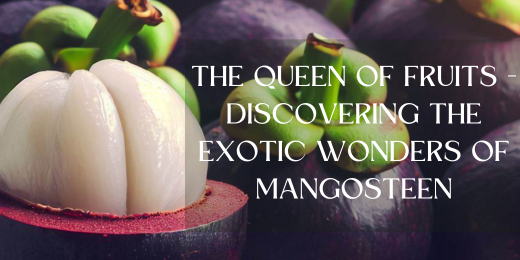
The Queen of Fruits – Discovering the Exotic Wonders of Mangosteen
Allow us to introduce the extraordinary mangosteen, hailed as the Queen of Fruits. With its regal reputation, mangosteen entices with its alluring characteristics and exotic allure. This tropical fruit, native to Southeast Asia, is renowned for its exquisite taste and captivating appearance. But its allure extends beyond aesthetics; mangosteen boasts a plethora of health benefits, including the benefits of papaya. Packed with essential nutrients, vitamins, and potent antioxidants, it offers a natural boost to the immune system, anti-inflammatory properties, and potential anti-cancer effects.
Mangosteen’s unique combination of sweetness and tanginess makes it a delightful addition to various culinary creations. As we dive deeper into the marvels of this fruit, we will uncover its traditional medicinal uses, cultivation methods, and ways to embrace the benefits of mangosteen as part of a healthy lifestyle.
Nutritional Profile and Health Benefits of Mangosteen
Mangosteen, with its tantalizing taste and captivating appearance, offers not only a delightful culinary experience but also a wealth of health benefits. This tropical fruit boasts a rich nutritional profile, abundant in vitamins, minerals, and powerful antioxidants. Mangosteen is known to provide immune system support, bolstering our body’s natural defenses. Its anti-inflammatory properties can aid in reducing inflammation and alleviating related symptoms.
Moreover, preliminary studies suggest that mangosteen may possess potential anti-cancer effects, making it an intriguing fruit for further exploration. With its impressive array of nutrients and health-promoting compounds, mangosteen stands as a fruit with tremendous potential in supporting overall well-being. Incorporating mangosteen into our diets can provide a delicious way to reap the benefits of this remarkable fruit, along with exploring Indian jujube recipes for a diverse culinary experience.
Taste and Culinary Uses of Mangosteen
Mangosteen captivates the palate with its distinctive taste profile, blending sweetness and tanginess into a harmonious symphony of flavors. Its succulent, juicy flesh offers a burst of tropical sweetness, reminiscent of a medley of tropical fruits. The tangy undertones provide a pleasant contrast, adding depth to its flavour profile. This delectable fruit finds its way into a range of culinary creations, both traditional and modern.
It can be enjoyed fresh as a standalone fruit, added to fruit salads for a refreshing twist, incorporated into smoothies and desserts, or used as a delightful garnish. The versatility of mangosteen makes it a prized ingredient, enhancing the taste and visual appeal of various dishes, while also providing the numerous benefits of mangosteen to those who relish its unique flavours. Similarly, the health benefits of jamun fruit include improved blood sugar control and a rich source of antioxidants, making it a nutritious addition to your diet.
Traditional and Medicinal Uses of Mangosteen
Mangosteen, revered in traditional medicine for centuries, holds a significant place in historical and cultural practices. This regal fruit has been utilized for its potential therapeutic benefits in various aspects of well-being. Traditional medicine often employed mangosteen to address digestive issues, thanks to its reputed ability to soothe the stomach and promote healthy digestion.
Moreover, its natural anti-inflammatory properties have made it a popular remedy for alleviating skin conditions and promoting skin health. Mangosteen’s rich antioxidant content has also been associated with supporting overall well-being. While scientific research is ongoing, these traditional uses highlight the potential of mangosteen in enhancing health and promoting holistic wellness. Additionally, just as with the benefits of sapota, mangosteen offers a range of potential advantages to explore.
Growing and Harvesting Mangosteen
Growing and harvesting mangosteen requires specific conditions and careful techniques. Mangosteen trees thrive in tropical climates with high humidity and consistent rainfall. They prefer well-drained soil and partial shade to protect the delicate fruits from direct sunlight. Cultivating mangosteen trees involves patience, as it takes several years for the tree to bear fruit. Once the trees mature, skilled farmers hand-pick the ripe mangosteen fruits to ensure their quality.
Harvesting at the right time is crucial to maintain their freshness and flavor. The outer purple rind is gently removed to reveal the creamy, white segments inside, which are enjoyed for their sweet and tangy taste. To preserve their freshness, mangosteens are typically stored at cool temperatures or consumed immediately. The careful cultivation and harvesting techniques are essential to deliver the exquisite taste and benefits of mangosteen to discerning fruit enthusiasts.
Conclusion: Embracing the Exotic Marvel of Mangosteen
In conclusion, mangosteen truly stands as an exotic marvel with its enchanting qualities and diverse array of benefits. From its captivating taste profile combining sweetness and tanginess to its rich nutritional composition packed with vitamins, minerals, and antioxidants, mangosteen offers a treasure trove of goodness.
Its potential health benefits, including immune system support, anti-inflammatory properties, and potential anti-cancer effects, further add to its allure. By incorporating mangosteen into our diets, we can embrace this extraordinary fruit and embark on a healthy and adventurous lifestyle. Let us unlock the benefits of mangosteen and relish its unique flavours, all while reaping its remarkable advantages for our overall well-being.